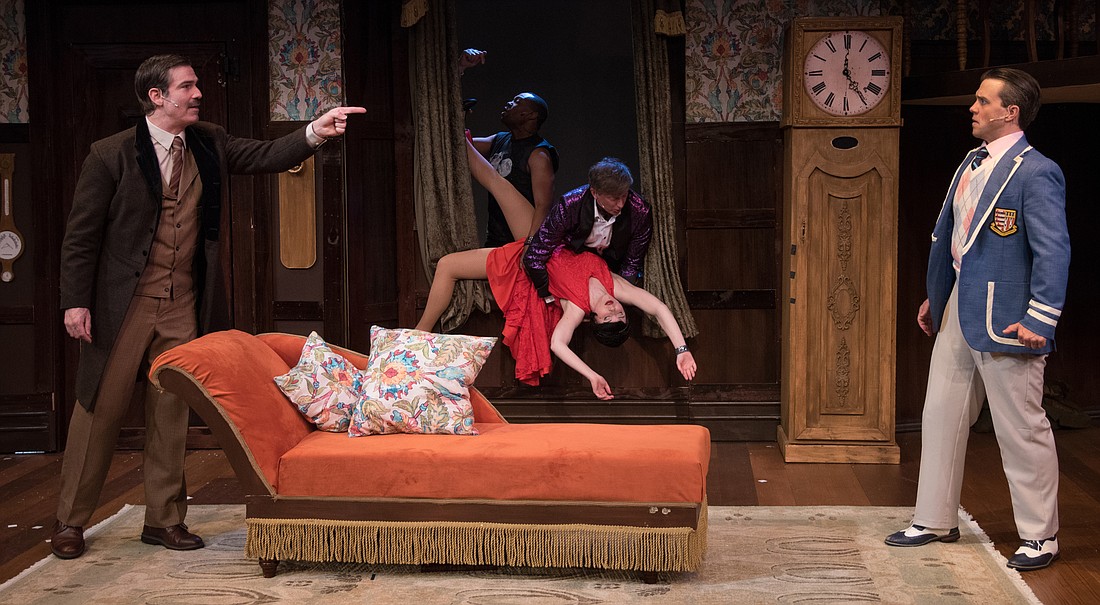- April 8, 2025
-
-
Loading

Loading

Florida Studio Theatre’s production of “The Play That Goes Wrong” is an unmitigated theatrical disaster.
I mean that in a good way.
Henry Lewis, Jonathan Sayer and Henry Shields’ comedy is supposed to be an unmitigated disaster.
If everything goes wrong, that means it all went right. Allow me to explain.
This show is every theater director’s worst nightmare, the thespian equivalent of that dream where you’re taking a final exam you haven’t studied for and suddenly realize you’re naked.
The conceit is that you’re watching a community theater’s performance of “The Murder at Haversham Manor,” a hackneyed rip-off of an Agatha Christie-style whodunit. Where Michael Frayn’s “Noises Off” spoofed the egos and insecurities of various actors, “The Play That Goes Wrong,” doesn’t focus on inner life.
It’s all about the machinery of theater. And what happens when it all goes haywire.
Slapstick abounds in the spirit of Monty Python, The Three Stooges and Buster Keaton.
Walls collapse, doors won’t open, stuff breaks, and actors bump their heads.
Things fall apart — and it’s hilarious. Director Bruce Jordan shows perfect comic timing in this imitation of bad timing. Much like classical ballet or juggling chainsaws, the art of slapstick has very precise rules. For the audience, each scene is like watching a milk bottle about to fall off a table. The spilled-milk expectation makes the inevitable crash funny.
Predictability kills the joke. It’s a fine line to walk, but Jordan pulls it off. The actors do, too.
Timothy Goodwin plays the apparent corpse of Charles Haversham. His “murder” is the inciting incident that sets this theatrical train wreck in motion. (He’s hilarious as a stiff that won’t stand still.)
Scott Cote is also a hoot as Perkins, the Butler character who can’t remember his lines (or pronounce them).
Gil Brady’s Chris is a pompous, overstuffed inspector in the lineage of John Cleese’s self-important twits.
Jacqueline Jarrold’s Sandra (an amateur actress) and Emily Berman’s Annie (the stressed-out stage manager) go to war when the part of Florence, the vamp, is up for grabs after too many head injuries.
Jordan Ahnquist’s Max is the dead man’s brother (and the vamp’s other lover). He’s also a canned ham — and chews up the scenery whenever he can. John Long plays the vamp’s brother. (He thinks he’s the reincarnation of Errol Flynn. He’s not.)
Trevor (Freddie Lee Bennett) is the lighting and sound manager who’s trapped in this circle of amateur drama hell.
Designers Isabel Curley-Clay and Moriah Curley-Clay bring the play to life with an entropic set. No flights of fancy this time. This show is a Rube Goldberg mousetrap — and it’s more like the kids’ game than Agatha Christie’s whodunit.
The designers worked within very narrow parameters and did their job with no loss of life or limb. Costume designer April Andrew Carswell smartly evokes the tatty threads of community theater. Lighting designer Devorah Kengmana actually made me laugh in a dramatic scene where an actor’s face turned as yellow as Lemonheads candy.
Kudos also to fight choreographer Paul Nicholas for making sure the pretend mayhem didn’t send anybody to the hospital.
This is a very funny play — and a bit of a guilty pleasure. It’s pure schadenfreude; there’s no denying it. Especially for yours truly. I’m not only a theater critic. I’m the son of a theater critic.
Over the decades, I’ve seen my share of lost wigs, flubbed lines, stuck doors, and grounded Peter Pans. These fails flooded into my mind while watching this play. I couldn’t stop laughing.
And to any of you real-life actors who actually lived these disasters?
In all sincerity, I’m glad it was you and not me.